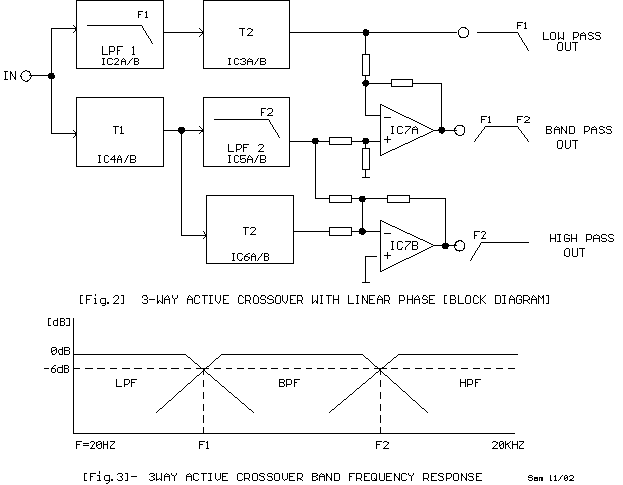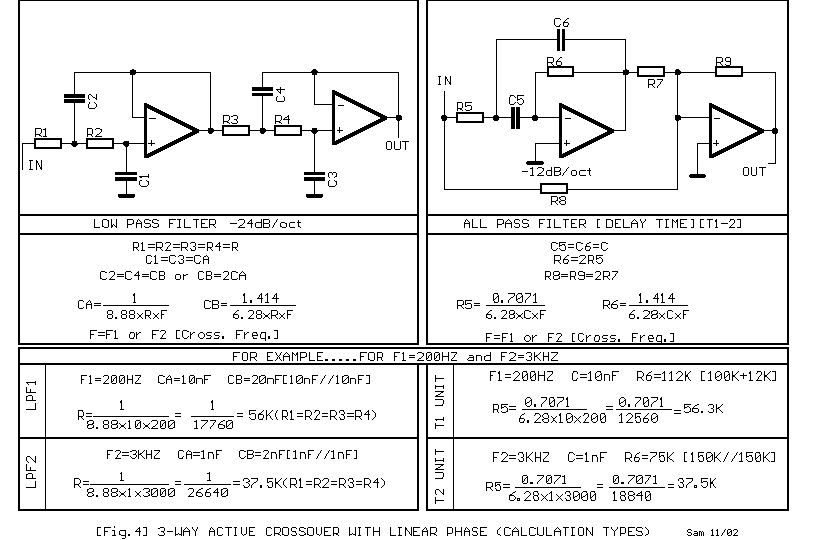3-Way Active Crossover with Linear-Phase Response |

|
| The problems that exist in common crossover
networks are known. The low-pass filter causes delay in the signal. On the contrary the
high-pass filter causes be pre-ahead in the signal that it in goes through from this. So,
the cross-frequency are created certain problems as 1] the signals of two filters
confutation 2] the change of phase between the filters influence axial 3]to axial
diagram depend from the frequency. The crossover circuit try it unties many from the
problems that report above and are based on research of S. Lipshitz and J. Vanderkooy that
was published in the magazine JAES (Journal Audio Engineering Society). A network
crossover of linear phase it uses a low-pass department with the help of circuit of time
delay and circuit of abstraction it gives in the exit signal with characteristically
low-pass filter. This delay time is not constant for entire the area of frequencies, but
is altered very late and mainly doesn't exist differences of phase between the signals of
two outputs, neither even near in the cross-frequency.
|
| R1-16=100Kohms |
R23-24-25-26=37.5Kohms
[33K+4.7K] |
C12-13-20-21-22=1nF 100V MKT |
| R2-3-4-5=56Kohms |
R30-31-32-33-34-35-36=10Kohms |
C19-23-24-30-31-32-33=47nF
100V MKT |
| R6-27=37.5Kohms[33K+4.7K] |
R37-38-39-40-41-41=10Kohms |
C25-26-27-28-29=1nF 100V MKT |
| R8-9-12-13-14=10Kohms |
R42-43-44=47Kohms |
C36-37=1uF 100V MKT |
| R10-28=75Kohms (150K//150K) |
R45-46=47 ohms |
C38-39=47uF 25V |
| R11-29=NC |
TR1-2-3-4=47Kohms trimmer or
pot. |
IC1=TL071 |
| R15=56.3Kohms |
C1-34-35=2.2uF 100V MKT |
IC2-3-4-5-6-7=TL072-NE5532 |
| R17=12Kohms |
C2-3-7-8-14-15-18=47nF 100V
MKT |
|
| R18-19-20-21-22=10Kohms |
C4-5-6-9-10-11-16-17=10nF
100V MKT |
All the rsestors is 1/4W 1%
metal film |
|

|
| The crossover circuit is constituted as it
appears from block diagram [Fig.2] from two low-pass filters of fourth
order -24db/oct, one for the line of low frequency signals and one for the
high frequency. In the same frequency function also the two delay-time units, T1 (for low
cross frequency F1) and T2 (for high cross frequency F2) and give him of
characteristically phase with the low-pass part. The circuit delays T1 imitate the delay
time that import the filter of low frequencies LPF1, while the T2 imitates the delay time
that import the filter of low frequencies LPF2 that exists in the line of mid frequencies.
Then the signal that emanates from low-pass filter is removed with IC7A-B, from the signal
that has suffered delay, result a signal that his characteristics is same with a signal
that has passed in from a low-pass filter. In the exit of each line found a trimmer with
that we can adjust the level and level between the loudspeakers. The circuit supply
become from a stabilized voltage +/- 15V. The use of crossover networks of fourth-order
Linkwitz heaves the cross-frequencies to find in -6db [Fig. 3]. |

|
In picture [Fig.
4], appear the basic circuits and the necessary types of calculation for the
low-pass filters as well as circuits delay time. Also exist an example of calculation for
crossfrequencies F1=200HZ and F2=3KHZ, that it will help in the calculation and the
adaptation in your needs. The circuit comes from relative article of magazine Elektor.
More theoretical details exist in article, also in relative articles of S.
Lipshitz and J. Vanderkooy in the JAES. |
Sam
Electronic Circuits 11/02 |
|
|


